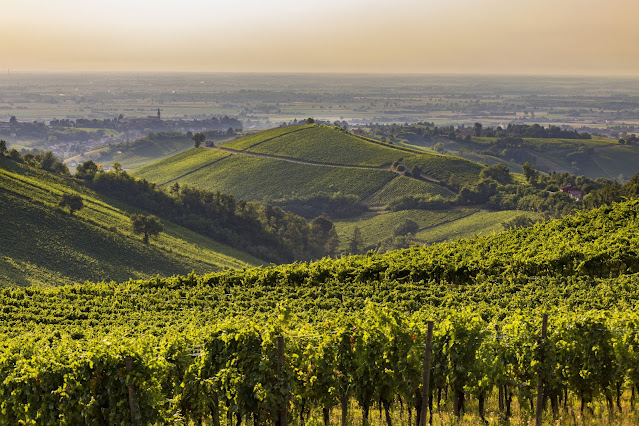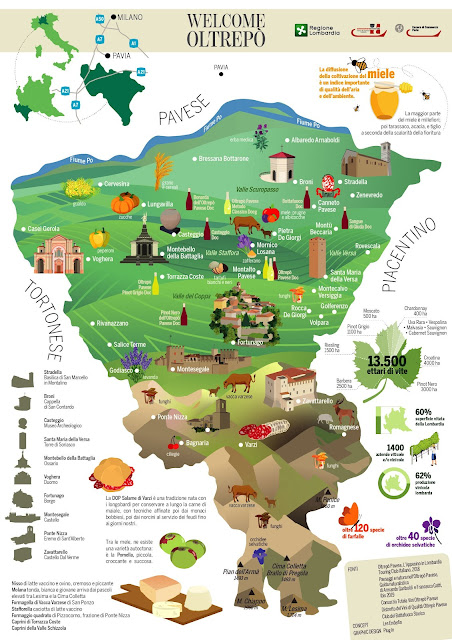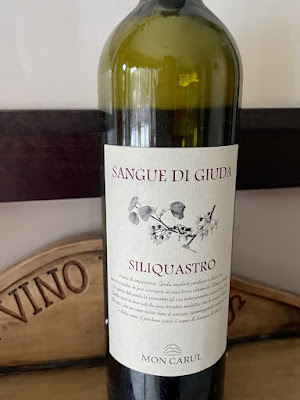This past week I had the pleasure of attending a webinar with Susannah of Vigneto Communications as she is an ambassador for the Oltrepo Pavese wine region of Lombardy. A group of wine writers shared in a large variety of wines from this region and I had the opportunity to try a few myself that I’m sharing with you today. What fantastic wines and information shared about this fascinating wine region. How many of you can say you are familiar with the Oltrepo Pavese wine region? If it’s not on your radar it’s time to get there and start to discover them.
The region ~ Oltrepo Pavese
The Oltrepo Pavese, pronounced “ol-tray-po pah-vay-say", translates to “the other side of the Po”, which is the longest river in Italy. You can find this wine region located about 25 miles outside of Milan. It’s a very hilly area, compared to Tuscany for its terrain and beauty. It consists of four valleys which form the shape of grape clusters from south to north including Valle Staffona, Valle Coppa, Valle Scuropasso and Valle Versa.
There is evidence of vines in this area since 1876 that were discovered in a fossilized vine trunk found near Casteggio. The Greek philosopher, Strabone, wrote of viticulture in this area as far back as 40 B.C. Sixty-two percent of the viticulture in Lombardy takes place in the Oltrepo Pavese with over 1,700 wineries covering almost 33,500 acres of land.
 |
| Copyright of Consorzio Tutela Vini Oltrepo Pavese |
In 1884 this region grew 225+ grapes, but today have narrowed down the focus to 10 grape varietals with Pinot Nero leading the pack along with Barbera, Riesling and Croatina. There is also a lot of Pinot Grigio grown there as well. This area is located on the 45th parallel, the same parallel for great Pinot Noir coming from Oregon and Bordeaux. Pinot Nero has been grown here since the 1800’s and is the 3rd largest area in the world after Champagne and Burgundy. Croatina is the grape used in the Bonarda DOC found here, but is not the same as the Bonarda grape in Piedmont. Of course, we’re talking Italian wine so why should it be so easy to understand?!
When we’re looking at what factors affect the wines grown in a particular region we always look at the climate and geographical influences. The Oltrepo has Mediterranean influences comingfrom the Ligurian Sea to the south. To the west are continental influences that stem from the Po River and the mountains of Piedmont.
 |
| Copyright of Consorzio Tutela Vini Oltrepo Pavese |
The Wines
It’s surprising to see Riesling in Italy, but with Germanic influences in northern Italy it’s no surprise this is where you would find it. You may see both Riesling Renano and Riesling Italico used, but it’s more common to see the German Riesling Renano used.
The 2020 La Travaglina Rugiade Riesling Oltrepo Pavese DOC was a brilliant straw color with a beautiful nose of stone fruit and pineapple. It seemed almost slightly frizzante upon first sip, which seemed to go away, but it had a mouthwatering acidity with crisp, tart, citrus and peach noes that finished with a tingling on the tongue. Our group had other versions of Riesling with a high amount of petrol commonly found on the palate, but with such diversity in terroir here you get to sample a variety of styles. La Travaglina started in the 1960’s and is named after the farm that is situated up on the hills of Santa Giuletta occupying over 80 acres of vineyards. ABV 12.5%
As mentioned previously that the Oltrepo has a long history with both Pinot Grigio in a still or frizzante style that can be used in its own DOC or via the Metodo Classico way. I sampled the 2021 Vanzini Oltrepo Pavese Pinot Grigio DOC. This family has been producing wine since 1890 and owns about 80 acres and utilizes another 80 acres owned by others. Their vineyards are spread aross 5 villages with vineyards that are about 400 meters above sea level. The 2021 Vanzini Pinot Grigio was very pale yellow in color with pretty aromatics of citrus and some tropical fruit. A very straightforward, everyday light-bodied Pinot Grigio that is soft and clean on the palate with apple and citrus notes.
After a couple whites we’re ending the wine tasting today with a dessert wine. This was a first for me for a wine known as Sangue di Giuda, the blood of Judas. Legend has it that after Judas’s death he regretted his actions towards Jesus and asked for repentance. He was resurrected and went to the village of Broni to save some of the vineyards there with a blood sacrifice, which was instructed by a local villager. Before he could sacrifice himself a force stopped him and the vineyards grew back into being fruitful and so the local villagers named the wine after him. Quite the graphic story if you ask me!
Sangue di Giuda is a sweet wine under it’s own DOC that has requirements of 25-65% Barbera, 25-65% Croatina and up to a maximum of 45% of Uva Rara, Ughetta and Pinot Nero. The 2021 Mon Carul Siliquastro Sangue di Giuda dell’Oltrepo Pavese DOC is made frizzante as a semi-sweet sparkling wine. With 40% Croatina, 40% Barbera and 20% Uva Rara. An interesting dessert wine compared to others I have tried. Ruby in color with purple highlights. It smelled like grape jelly on the nose with some hints of raspberries. Very smooth on the palate with notes of baking spices.
How familiar are you with the wines of the Oltrepo Pavese?


No comments:
Post a Comment